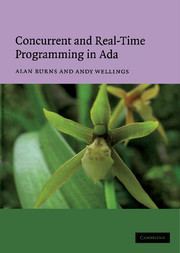Book contents
- Frontmatter
- Contents
- Preface
- 1 Introduction
- 2 The nature and uses of concurrent programming
- 3 Inter-process communication
- 4 Task types and objects
- 5 The rendezvous
- 6 The select statement and the rendezvous
- 7 Protected objects and data-oriented communication
- 8 Avoidance synchronisation and the requeue facility
- 9 Exceptions, abort and asynchronous transfer of control
- 10 Object-oriented programming and tasking
- 11 Concurrency utilities
- 12 Tasking and systems programming
- 13 Scheduling real-time systems – fixed priority dispatching
- 14 Scheduling real-time systems – other dispatching facilities
- 15 Timing events and execution-time control
- 16 Real-time utilities
- 17 Restrictions, metrics and the Ravenscar profile
- 18 Conclusion
- References
- Index
Preface
Published online by Cambridge University Press: 10 December 2009
- Frontmatter
- Contents
- Preface
- 1 Introduction
- 2 The nature and uses of concurrent programming
- 3 Inter-process communication
- 4 Task types and objects
- 5 The rendezvous
- 6 The select statement and the rendezvous
- 7 Protected objects and data-oriented communication
- 8 Avoidance synchronisation and the requeue facility
- 9 Exceptions, abort and asynchronous transfer of control
- 10 Object-oriented programming and tasking
- 11 Concurrency utilities
- 12 Tasking and systems programming
- 13 Scheduling real-time systems – fixed priority dispatching
- 14 Scheduling real-time systems – other dispatching facilities
- 15 Timing events and execution-time control
- 16 Real-time utilities
- 17 Restrictions, metrics and the Ravenscar profile
- 18 Conclusion
- References
- Index
Summary
The development of the Ada programming language forms a unique and, at times, intriguing contribution to the history of computer languages. As all users of Ada must know, the original language design was a result of competition between a number of organisations, each of which attempted to give a complete language definition in response to a series of documented requirements. This gave rise to Ada 83. Following 10 years of use, Ada was subject to a complete overhaul. The resulting language, Ada 95, had a number of significant changes from its predecessor. A further 10 years of use has produced another version of Ada, known as Ada 2005, this time the changes are less pronounced and yet there are some key extra facilities, especially in the areas of real-time programming.
Closely linked to the development of Ada has been this book on its concurrent features. Starting out as ‘Concurrent Programming in Ada’, it became ‘Concurrency in Ada’ when the Ada 95 version of the language was defined. There were two editions of this title. With the new features of Ada 2005, it has been decided to broaden the focus of the book to include real-time issues – hence this first edition of the new title ‘Concurrent and Real-Time Programming in Ada 2005’. No prior knowledge of concurrent programming (in general) or of Ada tasking (in particular) is assumed in this book. However, readers should have a good understanding of at least one high-level sequential programming language and some knowledge of operating system principles.
This book is aimed both at professional software engineers and at students of computer science (and other related disciplines).
- Type
- Chapter
- Information
- Concurrent and Real-Time Programming in Ada , pp. xi - xivPublisher: Cambridge University PressPrint publication year: 2007

